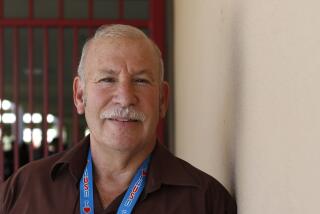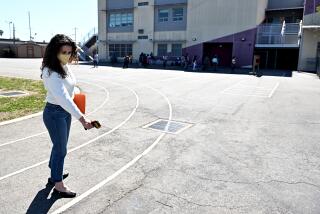This Fix-It Job Needs More Than Bob Vila
The faded walls around him, walls that haven’t seen fresh paint in ages, are a constant reminder to Chuck Ferrero that his profession is as much magician as athletic director.
Ever since he stashed his coaching whistle, giving up the reigns of the Valley College football team after the 1990 season to oversee the school’s athletic program, Ferrero has become closely acquainted with shoestrings, smoke and mirrors.
Such things have been essential to junior college athletic budgets for practically an eternity. They have turned guys such as Ferrero into Mandrake, trying to take dollars and multiply them.
Maybe that’s the reason Ferrero doesn’t turn cartwheels when he hears about large bundles of money earmarked for junior colleges, like the $22 million the Los Angeles Community College District is due to disperse shortly among its nine campuses.
The money is the district’s share of a $3-billion school and college construction bond measure approved by California voters in March. It’s also a supplement to the $3.1 billion budget for junior colleges that Gov. Pete Wilson signed in July, which is $200 million more than the previous year’s budget.
But Ferrero, a weary veteran of budgetary war rooms, is assuming a guarded posture.
“It’s not some big pie in the sky that’s dropping down on us,” Ferrero said. “It’s a glimmer of hope, but it’s a distant glimmer. But then again, it’s a lot more than we’ve had in the past years.”
None of that money might ever trickle down to the athletic departments, even though sports facilities at many junior colleges are sorrowful. Or nonexistent.
Mission, for instance, doesn’t have a gymnasium. The Sylmar school’s physical education facility is off-campus, in a warehouse on Foothill Boulevard.
At Valley, Ferrero can see the long line of money-seekers forming ahead of him. Which is pretty much the same vantage point for athletic directors and coaches at other area junior colleges. All they can do is take a number and wait to see if it’s called.
Even that can be deceiving sometimes. Just ask the folks at Mission and Pierce.
In June, those schools believed they were in the running for some cash when the district’s board of trustees voted to tax one million parcels of land to raise about $205 million for campus improvements.
Pierce had a $23.1 million proposal to expand the football stadium to seat 15,000. Mission wanted to buy land adjacent to the campus to build a recreation complex and a soccer field.
But the proposed tax plans crumbled when homeowners in the 882-square-mile college district, who had not been informed by the trustees, protested the $12 each would have had to pay. Many homeowners said they were not opposed to the tax on principle but resented how it was handled by the trustees, who invoked an obscure law that did not require public approval for such a fee.
The measure has been put on the November ballot.
“Whatever money we get, the administration will prioritize and money only goes so far,” Ferrero said. “There are classrooms and bathrooms and buildings over here that have to be taken care of. . . You are not coming from the ground up. You are coming from subterranean.”
The $22 million will be distributed among the district’s schools based on enrollment. More students translates into more cash.
One way to attract more students is to offer better facilities.
“By making the overall campus more attractive, we attract more students and we get more money from the fund, so in the long run it’s going to improve the entire program, including athletics,” Ferrero said.
Starting, of course, with a little paint on those pale walls.
More to Read
Get our high school sports newsletter
Prep Rally is devoted to the SoCal high school sports experience, bringing you scores, stories and a behind-the-scenes look at what makes prep sports so popular.
You may occasionally receive promotional content from the Los Angeles Times.






